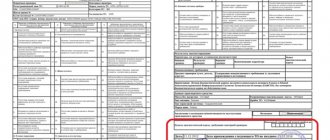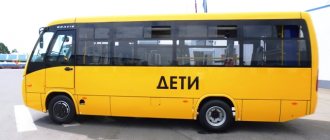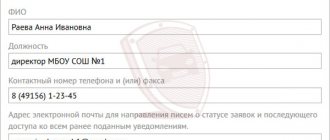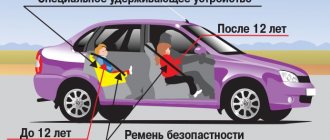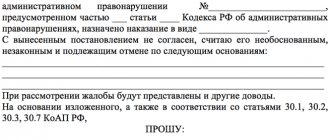Our children die in road accidents, what could be worse? We often ask the question: why do children get into traffic accidents? It would seem that the answer is simple: if a child, through his own negligence, is injured in a traffic accident, then it is the child’s fault. But the concept of “child’s guilt” does not exist. A road accident with him only means that we, adults, overlooked something, did not teach something, or showed by personal example that it is possible to break the “law of the road.” And often behind cases of child injuries on the roads is the indifference of adults to offenses committed by children. For a child, the ability to behave on the road depends not only on his desire or reluctance to do so. A child is the most vulnerable participant in road traffic, and in many ways, children’s behavior on the road is determined by their perception of the road situation. That is why the safety of children on the road can be ensured first of all by us, adults: parents, teachers, educators, passers-by and, mainly, vehicle drivers. Where does child safety on the road begin? Of course, with timely training in the ability to navigate a traffic situation, nurturing the need to be disciplined on the street, prudent and careful. Personal example is the most intelligible form of teaching for a child.
Dear parents, remember: if you break traffic rules, your child will do the same!
Rules for organized transportation of a group of children by bus
During organized trips, rules for transporting children on the bus have been developed to ensure the safety of minor passengers.
Special regulations regarding the rules of organized transportation of children have been approved by law.
Specific requirements for transporting children by bus apply not only to the vehicle and driver, but also to the escort.
The rules for transporting groups of children were developed by the Ministry of Transport of the Russian Federation.
The Government Decree approved document No. 1177 dated December 17, 2013, where bus transportation of children by bus implies:
- transportation of minors by non-route vehicles;
- transportation of children's groups without representatives (parents, guardians, adoptive parents).
transportation of groups of children of 8 people or more;
The representative may be an accompanying child or a medical professional. The rules for the organized transportation of children do not apply to the transportation of children in the presence of their parents who are not included in the accompanying group.
The rules for organized transportation of small passengers include:
- compliance with the rules for boarding minors in a vehicle;
- preparation of documentation for transportation;
- driver compliance with a set of requirements;
- certain requirements for accompanying persons;
- escorting buses with minors from the traffic police.
"Taksimba"
Website: https://taximba.ru Phone: 8 (495) 2-666-222; 8 (499) 34-8888-7 Cost: from 290 rub./20 min. Child seat: +100 rub.
Every day, each vehicle in the fleet undergoes a detailed technical inspection to identify faults. All service drivers are professional drivers with excellent knowledge of the roads of the capital and its environs. You don't have to worry when ordering a taxi for an unaccompanied child in Moscow.
Especially for small passengers, each car is equipped with a child seat according to age.
Drivers for transporting children have experience communicating with passengers of different ages. They will support any conversation, find their way if the child gets sick in the car, open the window in time and offer some water.
Escort of the convoy by law enforcement officers
Buses with children are accompanied by representatives of the automobile inspection only if they are traveling from 3 or more vehicles in a convoy.
You must obtain permission from an authorized representative of the traffic police to allow children to travel on the bus.
The driver must have the original document and keep it for 3 years from the date of transportation.
It must be provided at the first request of the traffic police inspector.
The organizers of the planned trip must submit a written application no later than 2 days before the trip to the regional office of the State Traffic Inspectorate.
Notification of the organized transportation of children by bus is submitted by the head of the organization in person or by e-mail through the official website of the State Traffic Safety Inspectorate - https://www.gibdd.ru/letter/.
It must indicate:
- the length of time for which support will be required;
- travel route;
- Full name of the accompanying person;
- Full name of the driver and details of his driver's license;
- number of persons transported;
- indication of the license plate number of each bus.
If children are transported by 1-2 buses, then notification of the trip to the department is also sent to the traffic police.
It states:
- date of transportation;
- information about the company that organized the trip;
- number of minor passengers indicating age;
- travel route indicating destinations;
- Full name of the accompanying person;
- vehicle make and license plate number.
A copy of the application or notification with the traffic police marks that they are aware of the children’s trip must be with the driver.
Paperwork
To transport children, you should prepare the following documentation:
- list of children on this trip;
- copies of permits for transporting children;
- a boarding document indicating the seats for each child;
- notification from the traffic police or a copy of the application for escort;
- travel contract signed by the transport company and the customer;
- Full name of accompanying persons with telephone numbers and passport details;
- agreement with medical an employee to accompany minors if the trip takes more than 12 hours;
- information about drivers (full name, contacts, driver's license numbers);
- food list on the bus.
When planning your route, please note the following:
- travel schedule and travel times;
- time of stops for the physiological needs of children;
- stopping places for food, rest and excursions (including hotels).
"Children's Taxi"
Website: https://www.detskoetaxi.ru Phone: +7 (985) 765-1180; +7 (495) 765-1180 Cost: from 500 rub. Auto-nanny: 600 rub./30 min.
The company offers transportation services for parents with children, as well as unaccompanied children. Children's Taxi drivers are experienced employees with extensive experience in safe driving.
With a babysitting service, you can send your child to school, to classes, or to grandma’s house on your own. It is possible to always hire the same driver.
Buses for transporting children and technical requirements GOST R 51160-98
As of January 1, 2017, new rules for transporting children by school bus came into effect. This standard sets requirements for buses for transporting children, which are aimed at ensuring safety.
Applies to vehicles for children aged 6-16 years to travel on the roads of the Russian Federation.
Requirements for drivers and vehicles
By decree of the Government of the Russian Federation, changes to traffic rules came into force on July 12, 2021, adjusting the rules for transporting children on buses, as well as the rules for placing cars on the roadway.
According to this resolution, a bus that is no more than 10 years old from the year of manufacture can be used for organized transportation, as well as:
- The vehicle must meet the technical requirements for design and purpose.
- It is mandatory to have a diagnostic card or technical certificate confirming the serviceability of the bus.
- To be able to determine the location of a vehicle at any time of the day, a GLONASS satellite navigator must be installed.
- Each bus must have a tachograph, which monitors the driver’s rest schedule and the speed of the bus.
Only those drivers who have:
- rights with open category D;
- transportation license;
- medical clearance for the flight;
- experience driving a transport bus for at least 1 year out of the last 3 years;
- compulsory instruction on transporting children has been completed;
- the driver was not deprived of his license, and he did not commit administrative violations over the past year.
What should a school bus owner provide?
The owner of the school bus (educational school or other legal entity that has entered into an agreement for the transportation of children with the school) must obtain a license.
The bus must meet the license requirements
- The bus must be equipped to transport passengers;
- The bus is no older than 10 years from the date of issue;
- Mandatory technical inspection;
- The presence of a special “Speed Limit” sign, according to which children are not allowed to drive the bus at a speed of more than 60 km/h;
- Availability of a sign “Transportation of children”;
- Availability of a tachograph;
- Availability of GLONASS satellite navigation.
- Mandatory details: emergency sign, first aid kit, 2 fire extinguishers, wheel chocks, special vest for the driver.
What are the requirements for transporting children?
Bus drivers must be allowed to transport children if they have:
- medical record confirming that you have undergone a mandatory examination;
- daily pre-trip briefing on the safety of transporting children;
- daily pre-trip medical examination;
- continuous work experience (1 year or more) in category D.
In addition, a driver who is allowed to transport children must not have an administrative penalty under traffic rules for a year (deprivation of rights, arrest).
Rules for organized transportation of a group of children by bus in 2019
GOST 33552-2015 buses for transporting children applies to special vehicles for transporting persons from 1.5 years to 16 years in buses.
General technical requirements are aimed at ensuring the safety of minor passengers, their life and health, as well as the presence of identification marks and inscriptions.
According to GOST 33552-2015, buses must meet safety requirements . “Transportation of Children” identification signs must be installed on the front and rear of the school bus.
The bus body must be yellow. On the outside and sides of the bus there are contrasting inscriptions “Children!”
According to the new rules for transporting children on buses, which came into effect on July 12, 2021, it is prohibited to transport small children under 7 years old if the trip lasts more than 4 hours.
From 23:00 pm to 6:00 am, group transportation is only allowed to and from airports and railway stations. After 23:00 the distance should not exceed 50 km.
Organized transportation of children in a convoy on intercity buses lasting more than 3 hours must be accompanied by medical assistance. employee. Transport must have bottled water and a selection of food products.
No later than 2 days before the start of transportation, the contractor (charterer) and the customer (charterer) are required to provide an official notification to the traffic police inspectorate about the planned transportation by bus.
If it is planned to use 3 or more buses, the customer submits an application for a group of children to be escorted by traffic police vehicles.
Rules for picking up and dropping off children
When transporting children by bus, accompanying persons are obliged to ensure proper order during boarding and disembarking from the vehicle, as well as during stops and while the bus is moving.
Before boarding passengers, accompanying persons are required to:
- Using the existing lists, check those present and mark all the children on the list.
- Organize the gathering of children in a safe place; it should be at least 15 m away from the landing site.
- Organize the loading of luggage into a specially designated place for transportation or into the luggage compartment of the bus.
- Check the dimensions, contents and packaging of hand luggage in accordance with the requirements of the Rules for the carriage of passengers and baggage.
- Instruct children with the obligatory inclusion of questions:
- rules of behavior when stopping and moving a vehicle;
- procedure for boarding and disembarking from vehicles;
- rules of behavior in case of emergency situations and in cases of deterioration of health during travel.
The responsibilities of those accompanying the children's group include monitoring the health, behavior and diet of the children . Adults are also required to control the route and coordinate the movement of the bus in case of unforeseen situations.
During mass transportation, children are boarded only after the bus stops under the supervision of the driver and under the guidance of accompanying persons. They lead the children in an orderly manner to the boarding area through the front door of the vehicle (the younger children are lined up in pairs).
Organizers take turns seating small passengers and ensure that hand luggage is safely placed, does not limit the driver’s field of vision and does not pose a threat to the safety of children. After they are placed, the accompanying driver is informed about the end of boarding.
The accompanying persons leave the vehicle first.
During stops, children can only be disembarked from the vehicle through the front door. During parking, one attendant should be near the back of the bus, the other - in front, making sure that no one runs out onto the roadway.
Minors who have been previously included on the list by the manager are allowed on the bus. It can be changed unilaterally before the bus starts moving. That is, the group leader can change the list without notifying the carrier.
The legislation puts forward special requirements for drivers, organizers and vehicles, failure to comply with which may result in punishment for those responsible.
To help the organizers, the Main Traffic Safety Inspectorate of the Ministry of Internal Affairs of Russia prepared instructions on safety precautions and supervision of their implementation.
Rules for boarding and disembarking children according to traffic rules
According to the rules for picking up and dropping off children, during an organized trip the driver is obliged to:
- Check the list with the children and mark all those present; — Ensure the bus stops in a safe place; — Load children's luggage into the luggage compartment; — Check your hand luggage (size and contents); — Instruct children on the rules for boarding and disembarking, as well as on the rules of behavior during stops and movement, including in emergency situations. — Explain to children what to do if their health worsens or the need for help arises.
New rules for the organized transportation of children on buses from October 2021
Driving with a child on board a car involves a number of obligations and restrictions for the driver. But if we are talking about organized traffic on a bus with more than 8 children, then a special Government Decree has been developed for this. It is this that will undergo a number of changes in October 2021. New rules of conduct have been developed for the driver and accompanying person during the organized transportation of children by bus. Have groups of children without parents become safer? Does the new law apply to school buses and public transport? Let’s look at this article about the amendments.
What is this new law?
In fact, it is not entirely correct to call the law of change. Formally, they do not relate to laws, but are Resolution of the Russian Government No. 1196 on amendments to another PPRF - No. 1177. Thus, the first regulatory act simply amends the second one from the beginning of October 2021 - the basic rules for the organized transportation of a group of children on a bus.
Among the most important innovations:
- seat belts and children fastened in them are mandatory not only in intercity transport, but also on city buses for groups of children,
- more responsibility is transferred to the accompanying person,
- The deadline for submitting a permit to the traffic police for the organized movement of children is now only 24 hours.
What are the changes?
But there are still quite a number of changes. We'll look at them in order!
There will be no more tour operators by law
At the very beginning of the PPRF there is a definition of the terms used in the transportation rules. And one of them is excluded - the definition of a tour operator.
Likewise, any further mention of tourism industry workers in bus transportation of groups of children is excluded.
Every bus must be equipped with seat belts
From October 1, changes will be made to the requirements for buses carrying children.
- they must still be no older than 10 years of age,
- be in good condition,
- admitted to participate in the transportation of children and road traffic in general,
- equipped with a tachograph, as well as a Russian satellite system,
- and a new requirement - it must be equipped with seat belts for children.
A new list of everyone on the bus
Now the official list should contain not only information about children, but also:
- about those accompanying the organized transportation of a group of children (full name and telephone number),
- about the medical worker on the bus (full name and copy of the license or agreement with a medical institution that has such a license),
- other employees (full name, phone number and pick-up/drop-off points, if they are not traveling the entire route).
For the children themselves, you need to indicate in their list:
- surname, first name and patronymic,
- date of birth or age,
- parents' contact numbers,
- drop-off and pick-up points if they do not travel the entire transportation route.
The list of stops and overnight stays must be predetermined
In particular, the maintainer should have the following list:
4(1). To carry out the organized transportation of a group of children, the person responsible or senior responsible for the organized transportation of a group of children and coordinating the actions of drivers during multi-day trips must have with him a list of places of accommodation for children on vacation at night, which also contains the name of the legal entity or last name, first name and patronymic (if availability) of an individual entrepreneur who places children on vacation at night or operates in the field of providing hotel services, or the register number of a tour operator organizing transportation in the unified federal register of tour operators.
The storage period for documents after transportation has been reduced
Now all documents after transportation must be stored not for 3 years, but for 90 days. The exception is an accident with victims - then the same 3 years remain.
New notice periods for transporting children
Previously, notification of the upcoming transportation of a group had to be submitted no later than 2 days before it. Now there are 2 new deadlines:
- if the transportation is intercity, then 48 hours before it (no later),
- if urban or suburban, then within 24 hours.
The accompanying person must ensure that all children are wearing seat belts.
A new paragraph was added to the Government Decree on October 1:
The appointed accompanying person is obliged to make sure that children are fastened with seat belts before the bus starts moving, to control their use of seat belts along the route, to ensure order in the cabin, preventing children from getting up from their seats and moving around the cabin while driving.
Now let's look at the most common questions regarding the organized transportation of groups of minors.
Rules for transporting children from January 1, 2021
Details Category: Traffic rules Published 10/18/2020
The government has approved new rules for the organized transportation of children from January 1, 2021.
Resolution of the Government of the Russian Federation dated September 23, 2021 No. 1527 approved new rules for the transportation of children, which will come into force on January 1, 2021. These rules will be in force until January 1, 2027, the document says.
The rules establish requirements for buses, drivers, and accompanying persons. Thus, the new version excludes the ban on transporting children by buses over 10 years of age, which they tried to introduce since 2013, but were postponed each time.
Read all the details about the new rules for transporting children in the portal material.
Rules for organized transportation of a group of children by bus from January 1, 2021
The rules determine the requirements for organizing and implementing organized transportation of a group of children by buses in urban, suburban and intercity traffic.
Transportation by 1 or 2 buses
If the organized transportation of a group of children is carried out by 1 bus or 2 buses, before the start of such transportation, a notification about the organized transportation of a group of children is submitted to the traffic police department at the district level at the place where the organized transportation of the group of children begins.
Transportation of 3 or more buses
If the specified transportation is carried out by 3 buses or more, before the start of such transportation, an application is submitted to escort the buses by a patrol car (patrol cars) of the traffic police unit:
- if it is necessary to organize escort on public roads located on the territory of several municipalities within a constituent entity of the Russian Federation, closed administrative-territorial entities, several constituent entities of the Russian Federation - to the traffic police unit at the regional level at the place where the organized transportation of a group of children begins or the Special Purpose Center in the field of support road safety of the Ministry of Internal Affairs of the Russian Federation, Main Directorate for Ensuring Road Safety of the Ministry of Internal Affairs of the Russian Federation;
- if it is necessary to organize escort on public roads located within districts, cities and other municipalities, closed administrative-territorial entities, the Baikonur complex - to the traffic police unit at the district level at the place where the organized transportation of a group of children begins.
Submitting a notice of transportation of children
The notification is submitted by the person planning the organized transportation of a group of children, including the charterer or charterer (if the transportation is carried out under a charter agreement), in accordance with the form established by the Ministry of Internal Affairs of the Russian Federation.
Notification of organized transportation of a group of children is submitted:
- no later than 48 hours before the start of intercity transportation;
- no later than 24 hours before the start of transportation in urban and suburban services.
A notification about the organized transportation of a group of children may be submitted in respect of several planned organized transportations of a group of children along the same route, indicating the dates and times of such transportation. Such notification is submitted before the start of the first of the transportations specified in it.
Organization of transportation
If, according to the schedule, the travel time of a bus during organized transportation of a group of children exceeds 4 hours, children under 7 years of age are not allowed to be included in this group.
In the event of a delay in the departure of buses carrying out the organized transportation of a group of children, the transportation organizer notifies the parents (legal representatives) of the children and other persons involved in the organized transportation of the group of children, as well as the traffic police unit, if they made a decision to accompany these buses with a patrol car ( patrol cars).
While the bus is moving, children must be fastened to their seats with seat belts adjusted in accordance with the vehicle operating manual. Monitoring compliance with this requirement is the responsibility of accompanying persons.
Requirements for accompanying persons
The transportation organizer assigns to each bus used for the organized transportation of a group of children persons accompanying the children throughout the trip. If the group includes more than 20 children, the minimum number of accompanying persons is determined based on their presence at each bus door intended for boarding (disembarking) children. It is allowed to appoint one accompanying person if the group includes 20 or fewer children and if children are boarded (disembarked) through one door of the bus.
If there are several accompanying persons on the bus, the transportation organizer appoints one of them responsible for the organized transportation of a group of children on the corresponding bus, who coordinates the actions of the driver (drivers) and other accompanying persons on the specified bus.
If 2 or more buses are used for the organized transportation of a group of children, the transportation organizer appoints a senior person responsible for the organized transportation of a group of children, who coordinates the actions of the drivers of these buses and those responsible for these buses.
If the duration of the organized transportation of a group of children exceeds 12 hours and 3 or more buses are used for its implementation, the organizer of the transportation ensures that such a group of children is accompanied by a medical worker . In this case, organized transportation of a group of children without a medical worker is not allowed.
List of people on the bus
The transportation organizer draws up a list of persons other than the driver(s) who are allowed to be on the bus during transportation, including:
- children included in the group, indicating the last name, first name, patronymic (if any), age or date of birth of each child, as well as contact telephone numbers of his parents (legal representatives);
- accompanying persons indicating their last name, first name, patronymic (if any) and contact telephone number;
- medical worker indicating his last name, first name, patronymic (if available) and contact phone number.
During the organized transportation of a group of children, the person responsible for the organized transportation of a group of children or the senior person responsible for the organized transportation of a group of children must have a copy of the notice of a negative decision based on the results of consideration of the application for escorting buses with a car (vehicles) of the traffic police unit (when such a decision is made) or notifications about the organized transportation of a group of children and the list provided for in this paragraph.
If a child or other person included in the list fails to appear, information about him or her is deleted from the list. In addition to the driver (drivers), other persons other than those indicated in the lists are not allowed on the bus. Monitoring compliance with these requirements is the responsibility of accompanying persons.
A list containing adjustments is considered valid if it is certified by the signature of the person appointed:
- responsible for the organized transportation of a group of children, if 1 bus is used for the organized transportation of a group of children;
- the senior person responsible for the organized transportation of a group of children, if 2 or more buses are used to carry out the organized transportation of a group of children.
Requirements for buses for transporting children
To carry out the organized transportation of a group of children, a bus equipped with seat belts is used.
When a bus carrying out organized transportation of a group of children is moving, a yellow or orange beacon must be turned on on its roof or above it, providing a visibility angle in the horizontal plane of 360 degrees.
Requirements for drivers to transport children
The following drivers are allowed to drive buses carrying out organized transportation of groups of children:
- having, on the date of the start of organized transportation of a group of children, work experience as a driver of a category D vehicle for at least one year out of the last 2 years;
- who have undergone pre-trip instruction in accordance with the rules for ensuring the safety of transportation by road and urban ground electric transport, approved by the Ministry of Transport of the Russian Federation;
- who were not brought to administrative responsibility within one year before the start of organized transportation of a group of children in the form of deprivation of the right to drive a vehicle or administrative arrest for administrative offenses in the field of road traffic.
When carrying out organized transportation of a group of children, the driver must have with him a charter agreement (if the organized transportation of a group of children is carried out under a charter agreement) and a document drawn up in any form containing information about the transportation route, including:
- point of departure;
- intermediate points of embarkation (disembarkation) (if any) of children and other persons participating in the organized transportation of a group of children;
- destination;
- places of stops for meals, short rest, night rest (for multi-day trips) - in the case of organized transportation of a group of children in intercity traffic.
Transporting children at night
At night (from 23:00 to 6:00) organized transportation of a group of children is allowed:
- to and from railway stations;
- to and from airports;
- completion of the organized transportation of a group of children (delivery to the final destination determined by the traffic schedule, or to a place of overnight rest) in case of an unplanned deviation from the traffic schedule (if there is a delay along the way);
- organized transportation of a group of children, carried out on the basis of legal acts of the highest executive bodies of state power of the constituent entities of the Russian Federation.
Moreover, after 23:00 the transportation distance should not exceed 100 kilometers.
Replacing a bus for transporting children
If it is impossible to carry out or continue to carry out the organized transportation of a group of children due to an accident, a technical malfunction of the bus, an illness (injury) of the driver that arose during such transportation, or it is revealed that the bus or driver does not comply with the requirements of the rules, the transportation organizer or the charterer (in case of organized transportation of a group of children under the charter agreement) is obliged to take measures to replace the bus and (or) driver.
The replacement bus and driver must meet the specified requirements.
Upon arrival of a replacement bus and (or) a replacement driver, the documents are transferred to the driver of this bus. The driver and the person responsible (senior responsible) for the organized transportation of a group of children draws up an act of replacing the bus and (or) driver in any form, indicating the reasons for replacing the bus and (or) driver, the date and time of replacing the bus and (or) driver, last names, first names, patronymics (if available) and contact telephone numbers of the persons who signed such an act.
The original documents are kept by the transportation organizer for 3 years from the date of completion of each organized transportation of a group of children, during which a traffic accident occurred, as a result of which the children were injured, in other cases - for 90 calendar days.
Do children need to wear seat belts on public transport?
Necessary, definitely. But only if the bus is equipped with seat belts and regardless of whether it is a child or an adult.
Since October, legislation has been talking about the need to equip all vehicles for transporting children only when there is an organized movement of a group of children. We are not talking about all buses with children on board.
"Vozik"
Website: https://vozik.taxi Phone: 8-499-992-28-44; 8-812-628-84-44 Cost: from 200 rub. Child seat: +100 rub. Babysitter: on request
The fleet of the Vozik taxi service is always ready to provide its clients with a comfortable taxi with a child car seat, so that children can always get to their destination in comfortable conditions.
The company employs only experienced drivers who have received the appropriate license. The fleet contains only the best modern foreign cars, in which customers can feel as comfortable as possible.
You can order a children's taxi to transport adults with children or unaccompanied children.
What documents are needed to license a school bus?
Question “What documents are needed to license a school bus?” became relevant after changes were made to the current legislation. According to the requirements of Russian government regulations, permission for the organized transportation of passengers must now also be obtained for flights operated for the internal needs of an organization (in this case, a school).
This list also includes school buses that deliver children to their places of study or transport them along excursion routes. To be able to use a vehicle without claims from inspection authorities, you will need to obtain a license before June 29, 2019.
Who issues a license to transport children
A license to transport children and schoolchildren is issued by Rostransnadzor. If the school bus licensing documents are prepared incorrectly or incompletely, the licensing authority will refuse to issue a license to the applicant.
A license to transport schoolchildren (students) is issued within 120 days from the date of application. All issued licenses are recorded in a special Register of Licensees.
In case of violation of the rules for transporting children, the carrier will pay an administrative fine in the amount of 100 thousand rubles, the driver who carries out transportation without a license will pay a fine of 3000 rubles, and the responsible official will pay a fine of 25 thousand rubles.
If a private owner or legal entity operates without a license, the fine will be from 50 to 400 thousand rubles.
Which buses are subject to licensing?
The procedure for obtaining permits for transport services is regulated by federal law. It defines a list of activities that require a license to engage in. But until recently, this law had a number of exceptions, and vehicles that were used by schools were included in this list.
Decree of the Government of the Russian Federation No. 195 dated February 27 of this year introduces a number of changes to the Federal Law. The main changes concern the list of activities that require a license.
Thus, for passenger transportation, you now need to obtain permission if the following conditions are met:
- The vehicle belongs to categories M2/M3 (i.e. has more than 8 seats excluding the driver’s seat).
- The owner of the vehicle is an individual entrepreneur or legal entity.
- The transportation of passengers is carried out either for the purpose of making a profit or to meet the internal needs of the enterprise/organization.
The last point is especially important for schools. Previously, a bus could be registered with a school and used as needed, but today it is necessary to obtain permission to operate it.
Where to get permission?
Starting from this year, using a school bus for its intended purpose without obtaining a permit is prohibited under threat of a fine (if the violation is repeated, the equipment may be confiscated). To avoid this, you must complete the licensing procedure by the deadline specified in the resolution.
The only organization that issues permits in the field of passenger transportation is the Federal Service for Supervision of Transport.
Therefore, you need to submit an application and send documents to the territorial divisions of Rostransnadzor.
The procedure does not provide for the mandatory personal participation of the organization in obtaining a license. Therefore, the school can contact one of the companies that will take over the process of communicating with representatives of Rostransnadzor - as a rule, this facilitates the collection of documents and saves time.
What documents are needed to obtain a permit?
The list of documents for licensing passenger transportation in 2019 includes:
- A copy of the organization’s order, according to which an employee responsible for road safety is appointed (additionally, confirmation of certification in road safety is provided).
- A copy of the agreement with the medical institution that will carry out pre-trip examination of drivers.
- A copy of the agreement with the organization that will repair and maintain buses.
- Copies of driver documents (licence, work record, health certificate).
- Documents for all vehicles that the school will use in passenger transportation (ownership, title, etc.).
- Documents confirming that the vehicle is equipped with standard tachographs and equipment for GLONASS satellite navigation.
If the school does not have its own parking lot or garage, then to obtain a license you must also provide a parking agreement and copies of payment documents.
All documents for the organization itself must be submitted separately. After collecting the documentation package, a school representative or an employee of a third-party company fills out an application (a form approved by Rostransnadzor is used). The application and documents for licensing bus transportation are submitted to the territorial division of Rostransnadzor or sent there by registered mail.
A prerequisite for obtaining permission to transport children by school bus is payment of the state fee. The time required for consideration of the application and issuance of a license (or provision of a reasoned refusal) is no more than 3 working days.
"Caramel"
Website: https://karameltaxi.ru Phone: Cost: from 129 rubles. Child seat: on request Babysitter: on request
The Caramel company offers its clients to order a taxi to transport children. For the youngest road users, aged from 0 to 6 months, up to a year, a taxi with a car cradle is provided. For older children, car seats are available that are appropriate for their age and weight.
The company can organize transportation of a child unaccompanied by parents to a school, lyceum, gymnasium, music school, sports section, and even to the region, for example, to a dacha or to a sports or health camp. Your child will be provided with a vehicle equipped with a car child seat or a comfortable booster seat. The cost of this service is calculated at the regular city or flat rate plus a minor surcharge for a child restraint system.
Requirements for operating a licensed bus
Not having a school bus license is not the only violation that can be punishable by fines. To avoid claims from Rostransnadzor and DPS, carefully comply with the requirements specified in the federal law (“Licensing Regulations”, Article 7):
- For transportation, you can use only those vehicles that were specified in the license. Inclusion of a bus in a license or its exclusion is carried out according to a separate procedure.
- Before a flight, equipment must undergo inspection. A pre-trip medical examination of the driver is also mandatory.
- Only drivers with category D licenses and having concluded an employment contract with the organization should be allowed to carry passengers. All persons involved in driving a vehicle must undergo training and scheduled training.
- When transporting passengers, the driver is required to use a tachograph, recording periods of driving, rest and other activities.
Between trips, buses must be parked in specially equipped parking areas or in boxes. Maintenance of vehicles is mandatory to ensure they are in full working order.
Both school bus licensing and operating regulations are mandatory today. The administration of educational institutions needs to take care in advance of obtaining all the necessary permits, and carry out a large amount of preparatory work - from concluding contracts with drivers and medical organizations to labor-intensive re-equipment of equipment with the purchase and installation of tachographs / GLONASS terminals.
